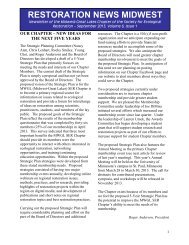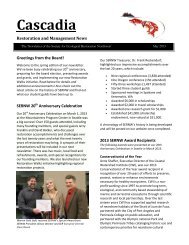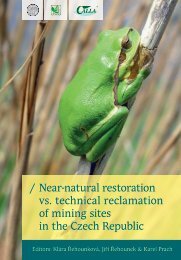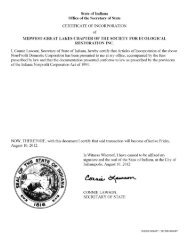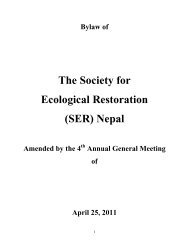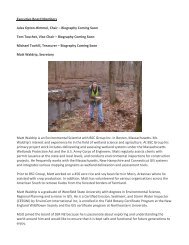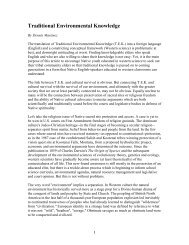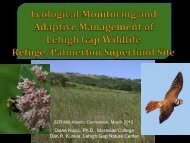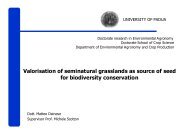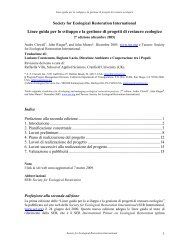THE WORLD CONFERENCE ON ECOLOGICAL RESTORATION
A Global Challenge - Society for Ecological Restoration
A Global Challenge - Society for Ecological Restoration
Create successful ePaper yourself
Turn your PDF publications into a flip-book with our unique Google optimized e-Paper software.
2005 The World Conference on Ecological Restoration 21<br />
Towards a more safe environment: (4) Disposability of uranium by some clay<br />
sediments in Egypt<br />
Abd-Allah 1 S.M., O.M. El Hussaini 2 , R.M. Mahdy 2<br />
1 Soils Dept., Fac. Agric., Ain Shams Univ. Cairo, Egypt. P.o.Box 68 hadayek shoubra 1124, Cairo, Egypt.<br />
2 Nuclear Materials Authority, Cairo, Egypt<br />
Due to the increase concerns about the environmental pollution problems, it is so important in waste<br />
disposal management to perform an accurate exploration of geological barriers, which must be suitable<br />
for waste materials disposal. Clay sediments play an important role as natural adsorbents to immobilize<br />
heavy and nuclear metals contaminants.For the present study, the clay samples were collected from either<br />
clay exploitation localities or from nearby radioactive mineralization in Egypt. Obtained results indicated<br />
that uranium adsorption and desorption differ importantly in accordance with the source of clay<br />
sediment used. In addition, its adsorption increases by increasing uranium initial concentration. The obtained<br />
data were found to fit of Langmuir equation isotherms. Adsorption maxima (B) for uranium were<br />
high for Abu Tartur bentonite followed by El Hafafit vermiculite and was the least for Kalabsha kaolinite.<br />
However, the binding energy (b) that affects the adsorption process can be arranged in the opposite direction.<br />
Desorption of uranium by HCl, NaOH and tap water show clear ability of the different sediments to<br />
release uranium. This was a function of leaching solution and binding energy. Finally, the changes in the<br />
clay sediments through adsorption and desorption processes were investigated in detailed by I.R spectroscopy.<br />
Keywords: adsorption-desorption, clay sediments, I.R, nuclear, pollution, uranium.<br />
Mycorrhiza: a tool for forest restoration in calcareous soils<br />
Adjoud-Sadadou D., R. Halli-Hargas<br />
Université Mouloud Mammeri de Tizi-Ouzou. Faculté des Sciences biologiques et des Sciences agronomiques. Département de<br />
Biologie. Laboratoire Mycorhizes.BP 17 RP Tizi-Ouzou 15000. Algérie<br />
Toxicity of calcareous soils is well established. This lead to the existence of large stripped and damaged<br />
areas. In this study we suggest to use mycorrhizal seedlings inoculated with suitable calcicole strains of<br />
mycorrhizal fungi in reforestation programs for calcareous soils. The mycorrhizal symbioses are mutualistic<br />
associations between plants and fungi. It has been unequivocally demonstrated that these associations<br />
confer many benefits to the plant and allow their establishment under many unfavourable ecological<br />
conditions. Eucalyptus camaldulensis, a calcifuge species, growing in a patch of calcareous soil in the<br />
north of Algeria was examined for mycorrhizal status. Results revealed that all the trees were mycorrhizal.<br />
Samples of this soil, containing the mycorrhizal fungus symbionts, were taken down to a depth of<br />
25 cm. around the trees and pooled together. Then, it was divided into 2 parts and one of them was sterilized<br />
to eliminate all the soil inoculum. Seedlings belonging to 3 calcifuge Eucalyptus species were germinated<br />
in sterilized peat-perlite mixture (60-40 v/v). After two months of growth, they were transferred<br />
into pots filled with soil sterilized or not. All the seedlings transferred into sterilized soil grew very poorly,<br />
showed leaf clorosis or died. Seedlings transferred into non sterilized soil grew well. Observation of their<br />
root systems revealed typical mycorrhiza, arbuscular mycorrhiza and ectomycorrhiza. It is obvious that<br />
the fungi which formed these mycorrhiza are calcicole strains, allowing seedlings of calcifuge Eucalyptus<br />
species to establish in such a calcareous soil.The information generated by this study should enable the<br />
nursery man to target which mycorrhizal fungi to select as suitable inoculant for calcifuge species in<br />
such calcareous soils.<br />
Keywords: Mycorrhiza. Reforestation. Calcareous soils. Calcifuge plant species.<br />
Restoring Atlantic wet dune slack habitats in an artificial recharge area<br />
Aggenbach 1 C.J.S., P.J. Stuyfzand 1,2 , M. Annema 3 , M.W.A. de Haan 1<br />
1 Water System Management Department, Kiwa Water Research, Nieuwegein, Netherlands<br />
2 Faculty of Earth and Life Sciences, Vrije Universiteit Amsterdam, Netherlands<br />
3 Evides, Ouddorp, Netherlands<br />
In an Atlantic coastal dune area the effects of changes in artificial recharge using river water (AR),<br />
groundwater discharge and management, on wet dune slacks, were studied at 12 locations differing in<br />
AR (stopped, unchanged, increased). Most of these locations were sod cut and grazed, some were also<br />
mown. Plant species composition, groundwater levels, nutrients in standing crop, chemistry of topsoil<br />
and groundwater were monitored for several years. At locations where AR stopped, Cl - , Na + , SO 4 2- levels<br />
in the groundwater dropped and visa versa. At locations with increased AR locally thin rainwater bodies<br />
developed in the topsoil rising dissolution of calcium carbonates. At locations with increased and un-



